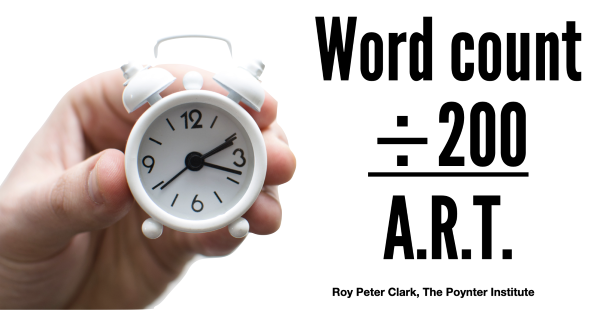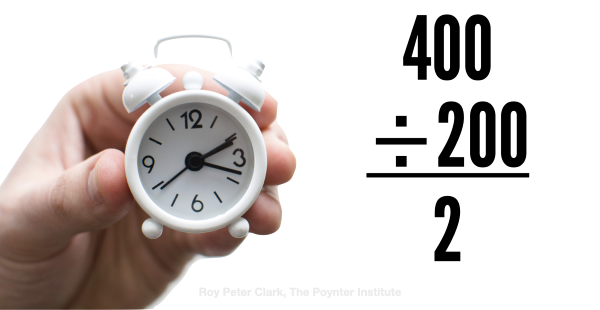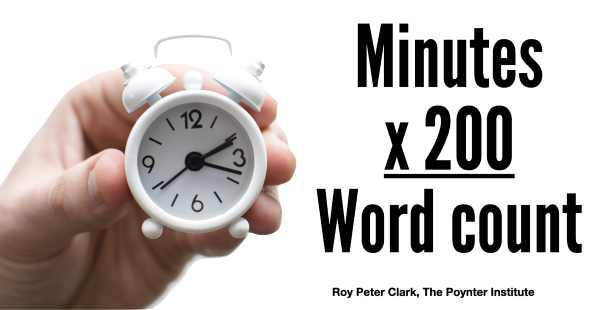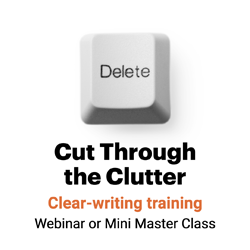Journalists spend less than 1 minute reading releases
Tick tock.
In the time it takes you to wash your hands, buckle your seat belt or start the dishwasher, your favorite journalist can finish reading your news release.

That’s right: Nearly 70% of journalists spend less than a minute reading a news release, according to a recent study by Greentarget. The rest spend one to five minutes.
So if your release is longer than 200 words, seven out of 10 journalists won’t finish it.
Why so short?
No wonder reporters don’t linger over your release:
- 45% of journalists surveyed get 50 or more releases per week.
- 21% get at least 100 per week.
- 40% get 10 to 50.
These folks are drowning in an ocean of content. Plus, years of media downsizing and increasing demands on journalists to produce digital content mean that their time is even more constrained.
As a result, “releases that are too long” is the fourth biggest pet peeve of the journalists surveyed by Greentarget. (“Releases that are poorly written” — ouch! — is No. 3.)
So how can you write a press release that’s short enough for everyone from small-business owners to search engines to love?
To reach these folks, you need to send a press release that’s attention grabbing — and no more than one-minute long.
How long is a one-minute release?
So how short is that?
To find out, you need to figure A.R.T., or average reading time.
Writers measure copy in words, inches or pages. Readers use a different measure: time.
So instead of using writer-centric measures, think like your reader and measure in time, suggests Roy Peter Clark, vice president and senior scholar at The Poynter Institute and author of Writing Tools.
Clark figures the average adult can read 200 words per minute. So to find A.R.T., divide your word count by 200.

So if your release is 400 words long, it will take two minutes to read.

You can also start with A.R.T. and divide by 200 words per minute to get your word count.

So if you are aiming for a one-minute release, you’ll want to limit it to 200 words.

200 words?
200 words.
Reduce the piece.
Journalists’ A.R.T. is just one reason to reduce the length of your release. If your release is:
- Longer than 700 words, Google News may reject it for being too long.
- Longer than 500 words, portals may truncate your release.
Plus, reading online is onerous. Releases of 200 words or so are easier on real readers’ eyes.
But don’t make it too short. If your release is:
- Shorter than 125 words, Google News may reject it for being too short.
Releases are too long.
Yet despite these guidelines, PR pros persist in writing really long releases.
We ran a quick sample of PR Newswire releases and found that they weighed in at a median of 600 words. That’s a three-minute read. They ranged as high as 1,723 words — about a 9-minute read.
Some PR pros on the other hand, are finding ways to drastically reduce the length of their releases:
- Nokia cuts its earnings release to 41 words.
- Pizza Hut famously introduced a new product with this 19-word release: “‘There’s bacon. In the crust! You’re welcome, America!’ said country music superstar and Stuffed Crust pizza aficionado Blake Shelton.”
- Christopher S. Penn boils his releases down to tweets.
- And I’m nuts for this one-word release.
How long are your releases? Would they be twice as good if they were half as long?
How to write a short pitch.
J.W. Elphinstone’s “Business Watercooler” feature for the Associated Press is just 200 words long. Why, then, do PR pros send her product or service pitches that are longer than that — even PowerPoint presentations with 30 slides?
Call it “AKK,”The New York Times’ acronym for “all known knowledge.” Your job isn’t to forward everything there is to know about your topic; your job is to find a tight story angle on the topic and to write an effective press release or pitch for the media.
So keep your pitches short. How short?
1. Keep it to three paragraphs.
Your pitch should be, at most, three paragraphs, suggests Peter Shankman, creator of Help a Reporter Out, or HARO.
That’s maybe 100 to 150 words. Include:
- The story angle. Focus on how this story will affect the journalists’ readers. Keep it the length of a social media post — a sentence or two. (Signal this in the subject line — in 40 characters or less.)
- What makes this story different. In the body copy, use bullet points or a couple of paragraphs to explain why your news story is a good idea for this outlet’s target audience.
- Contact information. Don’t forget important information like your email address and phone number.
Then “Best, Your Name” and out.
2. Make it 150 words.
The most effective pitches are short — 100 to 150 words. To keep yours fast and efficient, answer these four questions:
- Why you? Target the journalists and bloggers you pitch. Start with a personal greeting, and slant your story to their media outlet, column or segment.
- Why this? Give just enough detail to demonstrate that this story is different and worth covering.
- Why now? Create a sense of urgency. Show that this isn’t a generic, evergreen story but a story that should be covered right now. Make your lead timely or link it to a hot topic.
- Why us? Give an indication of authority and credibility. Without blah-blahing your spokesperson’s whole bio, show that she’s a credible —maybe even controversial — figure.
3. Think cocktail party.
When Barbara Goldberg, vice president of New York PR firm Belsito & Co., pitches a story, she thinks, “How could I get a friend at a cocktail party interested in two minutes or less?”
To promote the Surviving Sepsis Campaign, for instance, Goldberg pitched this story:
Too many of us know someone who went into the hospital for treatment of a common infection or even elective surgery — and never came out. The culprit is severe sepsis, which is treatable in most cases but needlessly remains one of the nation’s leading causes of death. It strikes two out of every 100 hospital admissions in the United States and kills 215,000 people each year, more than lung, colon and breast cancer combined.
4. Pass the one-leg test.
When expert PR professionals pitch by phone, they do so while standing on one leg. When their foot hits the floor, their pitch comes to an end.
So test your pitch. Read it aloud while standing on one leg. If you can’t finish before the second foot drops, you need to cut some copy.
Or time your pitch. Rick Frishman, president of Planned Television Arts, recommends that you limit your pitch to:
- 30 seconds of spoken word for print
- 10-20 seconds for radio and television
If your short pitch is good enough, he says, you’ll buy more time to sell your story.
Tease, don’t tell.
The job of the pitch is to pique the media’s interest, not to deliver all known knowledge. So just because you know it doesn’t mean it has to show up in the pitch.
Remember, you can always link to the full release for details. But don’t include the full release in your pitch.
And, please, no PowerPoint presentations.
___
Sources: “Why Your Release Might Not Make It In to Google News,” BusinessWired, March 24, 2010
Rebecca Corliss and Mike Volpe, “How to Be Smarter Than Your PR Agency: New Research on News Release Best Practices,” HubSpot, May 20, 2009
“Perfect Email Pitches: Master PR Scribes Reveal How to Craft Copy That Turns Heads and Earns Media Ink,” Bulldog Reporter’s PR University teleseminar, Sept. 18, 2008
“Turning complex into catchy,” Media Relations Report, September 2004

Leave a Reply